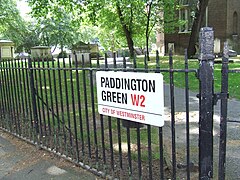Paddington Green, London
| Paddington Green | |
|---|---|
 |
|
| Paddington Green shown within Greater London | |
| London borough | |
| Ceremonial county | Greater London |
| Region | |
| Country | England |
| Sovereign state | United Kingdom |
| Post town | LONDON |
| Postcode district | W2 |
| Dialling code | 020 |
| Police | Metropolitan |
| Fire | London |
| Ambulance | London |
| EU Parliament | London |
| UK Parliament | |
| London Assembly | |
Paddington Green is a green space, conservation area and geographic location in Westminster located off Edgware Road and adjacent to Westway. It is the oldest part of Paddington and became a separate conservation area in 1988, having previously formed part of Maida Vale conservation area. At one time, the Green was surrounded by large Georgian houses, but now only two remain on the west side of the Green.
Paddington Green contains part of the ancient Paddington and Lilestone villages and became fashionable at the end of the 18th century because of its village setting and proximity to the West End of London. An omnibus service to the City of London was introduced in 1829 by George Shillibeer.
St Mary on Paddington Green Church is part of the Parish of Little Venice and is the third church on this site. The church was built in 1791 by John Plaw. Its graveyard – known as St Mary's Gardens (or St Mary's Churchyard) – contains monuments to notable local residents, including actress Sarah Siddons (also buried there), sculptor Joseph Nollekens and lexicographer Peter Mark Roget. The southern part of the graveyard was removed to make way for the flyover. Exhumed graves were re-interred in Mill Hill Cemetery.
The former Paddington Green Children’s Hospital (now an apartment block) stands on the north-east corner of the Green on Church Street. It is a Grade II Listed building. The Schmidt hammer lassen-designed City of Westminster College is located at 25 Paddington Green.
...
Wikipedia

